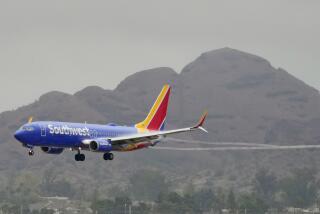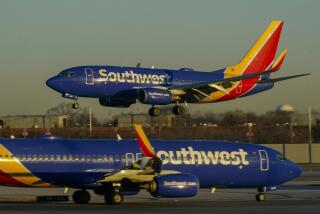Plans to cram more seats in airliners won’t sit well with fliers
- Share via
Airlines increasingly are missing scheduled takeoffs and landings, losing travelers’ bags and overbooking flights, according to a report released Monday.
And the bad news: Things will probably get worse.
Even as the latest performance stats showed that major carriers are having trouble with the most basic functions — i.e. getting you and your luggage from Point A to Point B — the outlook for future travel all but guarantees even less-friendly skies.
Boeing is planning to bring its new short-haul 737 MAX aircraft into service in 2017. It will have 189 seats, compared with the approximately 160 seats that now fill the cabin of the 737-800. Budget carrier Ryanair’s version of the new jet will have 200 seats.
For its part, Europe’s Airbus will unveil its A320neo next year. It was originally intended to have 180 seats, but the company received permission from the European Aviation Safety Agency last month to cram in 15 more seats, bringing total passenger capacity to 195.
What this means for travelers, at least those flying coach, is the likelihood of narrower seat cushions and the near certainty of less legroom.
Inches count when it comes to what’s known as seat pitch — the distance between your seat and the seat in front of you. The loss of a single inch can mean the difference between a halfway comfortable flight and an exercise in contortion.
The industry standard for seat pitch in coach used to be about 33 inches. These days, it’s closer to 31 or 30 inches.
In the new Boeing and Airbus jets, seat pitch could be as low as 27 to 29 inches, which means that if the person in front of you reclined his or her chair, it would practically hit you in the face.
Eric Gonzales, an assistant professor of civil engineering at the University of Massachusetts Amherst who specializes in transportation issues, said the trend has been clear for a while: More seats in coach, and to hell with passenger comfort.
“When it comes to passenger comfort, the airlines are saying that this isn’t something that’s very important to them,” he said. “These changes are intended solely to improve the bottom line.”
Not that airlines are hurting. Profits are near record highs, thanks to industry consolidation, dwindling competition and low oil prices.
Worldwide, the airline industry is expected to pocket $25 billion in profits this year after posting nearly $20 billion in profits last year, according to the International Air Transport Assn. Carriers in North America are expected to rake in $13.2 billion in profits this year.
Yet ticket prices, which soared as fuel costs rose in past years, aren’t coming down. Airlines say they’re pumping much of their massive profit into better aircraft.
Gonzales said one thing they’re spending their money on is lighter, cheaper seats with less padding, enabling the addition of whole new rows to coach sections.
“The easiest way for them to improve their margins even more is to fit more people into the aircraft,” he said.
Monday’s Airline Quality Ratings report from Embry-Riddle Aeronautical University and Wichita State University showed that carriers fell down on the job last year on a number of key performance measures.
Researchers found that more flights ran late, more bags were lost — one bag went missing for every 275 passengers — more flights were overbooked, more passengers were bumped and consumer complaints to federal regulators jumped 22%.
This followed four years of improvement for the industry, suggesting that with most flights now 80% full and many oversold, airlines have reached a tipping point in meeting passengers’ expectations.
Melanie Hinton, a spokeswoman for the industry group Airlines for America, formerly the less-cheerful-sounding Air Transport Assn. of America, said the latest Airline Quality Ratings don’t tell the whole story.
She said carriers performed well “amid severe winter weather in the first quarter” and “a stormy spring and summer.”
Recent airline mergers, Hinton said, “have allowed airlines to focus on renewing fleets, improving the product at all stages of travel.” She said carriers are only adding more seats to aircraft to meet growing demand for air travel.
Jami Counter, who oversees the airline industry on behalf of the travel website TripAdvisor, responded that carriers are making it sound like passengers themselves are to blame for cattle-car conditions.
“In the past, airlines added more flights to meet more demand,” he said. “Adding seats is an easy way for them to add capacity on the cheap, without adding more flights.”
Budget-minded air travelers have made clear that they’re prepared to tolerate all manner of indignities for lower fares, and airlines have had no problem making the experience of flying as uncomfortable and demeaning as possible.
As a result, we’ve seen a number of cases of air rage in recent months as flights have made emergency landings to deal with angry passengers fighting over reclined seats.
The question at this point is how much worse things can get. All-plastic, unpadded seats? Seats that don’t recline? Standing-room-only sections?
It’s time that the Federal Aviation Administration set minimum standards for passenger comfort. Seat pitch in coach should be at least 30 inches, and preferably 31 or 32 inches. Cushions should be at least 18 inches wide to prevent people from fighting for armrest space or spilling over into the adjacent seat.
It’s unlikely that flying coach will ever again be pleasant. But it doesn’t have to be a soul-crushing experience.
David Lazarus’ column runs Tuesdays and Fridays. He also can be seen daily on KTLA-TV Channel 5 and followed on Twitter @Davidlaz. Send your tips or feedback to david.lazarus@latimes.com.
More to Read
Inside the business of entertainment
The Wide Shot brings you news, analysis and insights on everything from streaming wars to production — and what it all means for the future.
You may occasionally receive promotional content from the Los Angeles Times.











